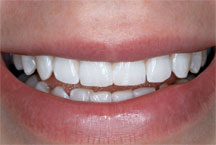Porcelin Veneers - A Work of Art
|
Porcelin veneers can resist staining associated with coffee, tea or cigarette and cigar smoking. Porcelain veneers typically last 10 - 15 years and is the most expensive cosmetic dentistry procedure. Porcelain veneers cost close to $1000 for each veneer. |
 |
| Dental veneers, like dental crowns and dental bonding, are usually used for cosmetic whitening purposes by people who have structurally sound teeth, but can also be prepared for people who require structural work on their teeth. Dental veneers are used to straighten the spaces between teeth that have become chipped or worn. Dental veneers work very well for crooked or poorly shaped teeth and can also be used to lengthen the teeth. |
Dental Veneers
Dental veneers are composed of ultra thin layers of ceramic or resin material that has been custom made to be bonded over the surface of the tooth. In addition to correcting cosmetic defects, they are also used to correct a person’s bite or to simply protect the tooth surface. There are two types of materials used in dental veneers, composite and porcelain. A composite veneer may be directly built up in the mouth or fabricated by a dental laboratory and later bonded to the tooth using resin cement, such as Panavia. Porcelin veneers can only be fabricated with the use of a dental laboratory. The process of creating either a porcelain or composite veneers is usually irreversible given that it is necessary to remove some enamel from your tooth in order to put the shell snugly on the tooth.
Previously, the only way to correct dental imperfections, such as a small chip, was to cover the teeth with a dental crown. But a porcelain or composite veneer procedure is often less invasive and less expensive than a dental crown and is therefore, the more popular dental cosmetic procedure. Porcelain or composite veneers can also be used to close tooth gaps or to disguise discolored teeth that did not respond well to a teeth whitener procedure.
Dental Veneer Process
Porcelain and composite veneers are often used to resurface the teeth as a way of making them appear straight and aligned. The dental veneer procedure usually involves three dental visits which consist of one consultation followed by the actual procedure process. After the consultation, an impression is made of your teeth which are then sent to a dental laboratory.
The dental laboratory will process the veneers for insertion, the final visit. Initially, the dentist will apply the veneers with a temporary substance, in order to check the fit and color. If necessary, the veneer may be sent back to the lab for further processing. If everything is okay, the final product is permanently cemented onto the teeth.
When the dental veneer is applied, it is important that they do not increase the thickness of the front face of the teeth. If the teeth are too thick, the dental veneers may appear to stand out, also pushing out the lips. This may result in a chipmunk appearance when the lips are closed. Dental veneers must also be created so that a patient uses a minimal amount of force when biting into them, otherwise they may chip. Patients who have the type of bite which may dislodge the veneer are not good candidates for a dental veneer procedure. Your dentist will be able to provide additional information about this issue.
Dental Veneer Aftercare
While it may take a little time to get used to the appearance and feel of porcelain or composite veneers, there is no special care needed. You should not bite any objects that can cause the dental veneers to come off. You should continue to maintain your oral hygiene program, which includes thorough brushing and flossing.
Advantages of Dental Veneers
There are many advantages of using porcelin veneers as a tooth restoration procedure. You can achieve a very good cosmetic appearance with a minimal amount of tooth preparation. This is not often the case with dental crowns. Composite veneers are the more popular of the two, as porcelin veneers have a tendency to fracture. Composite veneers are also thinner and therefore require less tooth structure removal before the veneer is applied. But, the advantage of using porcelin veneers over composite veneers is that porcelin veneers are more durable and less likely to stain, but it is still recommended that a person avoid excessive consumption of foods and drinks that tend to stain, such as coffee, tea or wine. If you tend to grind or clench your teeth, a porcelin or composite veneer can chip or fracture. When a dental veneer breaks, it cannot be repaired. The porcelin or composite veneer must be completely replaced.
Dental Veneer Video
| Here is a 2 minute video below explaining the use of CEREC for veneers and dental crowns provided courtesy of Dr. Simon Rosenthal, a dentist in the New York City area. According to the interview, the CEREC procedure is designed to not only save time, but the materials used are boasted to last for at least 30 years. Additional videos of other dental procedures, dental news and retro commercials can be found on the Dental Videospage. |
Dental Veneers Costs
Similar to dental crowns, a porcelain or composite veneers lasts between 10 and 15 years and some consider them to be the most expensive of the cosmetic dentistry procedures. Porcelain veneer cost between $600 - $1200 each and since several are usually recommended, the cost increases greatly. But, there is a way to get them even cheaper, for at least $500 each - see below.
